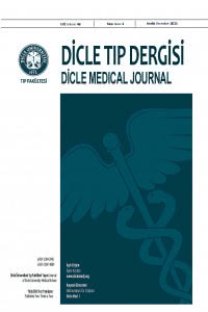Distribution of Candida species isolated from blood cultures in a university hospital
Bir üniversite hastanesinde kan kültürlerinden izole edilen Candida türlerinin dağılımı
___
- 1. Hidron AI, Edwards JR, Patel J, et al. NSHN annual up- date: antimicrobial-resistant pathogens associated with healthcare-associated infections: annual summary of data reported to the National Healthcare Safety Network at the Centers for Disease Control and Prevention, 2006-2007. In- fect Control Hosp Epidemiol 2008;29:996-1011. 2. Kett DH, Azoulay E, Echeverria PM, Vincent JL. Candida bloodstream infections in intensive care units: analysis of the extended prevalence of infection in intensive care unit study. Crit Care Med 2011;39:665-670. 3. Wisplinghoff H, Bischoff T, Tallent SM, et al. Nosocomial bloodstream infections in US hospitals: analysis of 24,179 cases from a prospective nationwide surveillance study. Clin Infect Dis 2004;39:309-317. 4. Guo F, Yang Y, Kang Y, et al. Invasive candidiasis in inten- sive care units in China: a multicentre prospective observa- tional study. J Antimicrob Chemother 2013;68:1660-1668. 5. Ells R, Kock JLF, Pohl CH. Candida albicans or Candida dubliniensis? Mycoses 2011;54:1-16. 6. Wey SB, Mori M, Pfaller MA, et al. Hospital acquired can- didemia: The attributable mortality and excess lengthy of stay. Arch Intern Med 1988;148:2642-2645. 7. Chen LY, Yang SP, Chen TL, et al. Clinical significance of time to positivity for yeast in candidemia. J Microbiol Im- munol Infect 2015;48:425-430. 8. Ma CF, Li FQ, Shi LN, et al. Surveillance study of spe- cies distribution, antifungal susceptibility and mortality of nosocomial candidemia in a tertiary care hospital in China. BMC Infect Dis 2013;13:337. 9. Bouza E, Muñoz P. Epidemiology of candidemia in intensive care units. Int J Antimicrob Agents 2008;32(Suppl 2):87- 91. 10. Ruan SY, Lee LN, Jerng JS, et al. Candida glabrata fun- gaemia in intensive care units. Clin Microbiol Infect 2008;14:136-140. 11. Montagna MT, Lovero G, Borghi E, et al. Candidemia in intensive care unit: a nationwide prospective observational survey (GISIA-3 study) and review of the European litera- ture from 2000 through 2013. Eur Rev Med Pharmacol Sci 2014;18:661-674. 12. Meyer E, Geffer C, Gastmeier P, Schwab F. No increase in primary nosocomial candidemia in 682 German in- tensive care units during 2006 to 2011. Euro Surveill 2013;18:20505. 13. Nawrot U, Pajaczkowska M, Fleischer M, et al. Candidae- mia in polish hospitals - a multicentre survey. Mycoses 2013;56:576-581. 14. Bergamasco MD, Garnica M, Colombo AL, Nucci M. Epidemiology of candidemia in patients with hemato- logic malignancies and solid tumours in Brazil. Mycoses 2013;56:256-263. 15. Çalışkan E, Dede A, Biten Güven G. Distribution and an- tifungal susceptibilities of Candida species isolated from blood cultures. Ankem 2013;27:25-30. 16. Atalay MA, Sav H, Demir G, Koç AN. Distribution of can- dida species ısolated from blood cultures and in-vitro sus- ceptibilities to Amphotericin b and Fluconazole. Medical Journal of Selçuk 2012;28:149-151. 17. Gültekin B, Eyigör M, Telli M, et al. A Retrospective Inves- tigation of Candida Species Isolated from Blood Cultures during a seven-year period. Ankem 2010;24:202-208. 18. Aslan U, Uysal EB, Işık F, et al. Candida species isolated in blood samples, 2002-2005 İnfeksiyon Derg 2006;20:177- 181. 19. Yenigün Koçak B, Kuloğlu F, Doğan Çelik A, Akata F. Evaluation of Epidemiological Characteristics and Risk Factors of Candidemia in Adult Patients in a Tertiary-Care Hospital. Mikrobiyol Bul 2011;45:489-503. 20. Yapar N, Pullukcu H, Avkan-Oguz V, et al. Evaluation of species distribution and risk factors of candidemia: a multi- center case-control study. Med Mycol 2011;49:26-31
- ISSN: 1300-2945
- Yayın Aralığı: 4
- Başlangıç: 1963
- Yayıncı: Cahfer GÜLOĞLU
Hipernatremili erişkin hastaların değerlendirilmesi: Tek merkez deneyimi
Ercan GÜNDÜZ, Yılmaz ZENGİN, Mustafa İÇER, Hasan DURGUN, Recep DURSUN, Ahmet GÜNDÜZALP, Mustafa İPEK, Cahfer GÜLOĞLU
Evaluation of folate and vitamin B12 levels in lead exposed workers
Murat BÜYÜKŞEKERCİ, CEYLAN BAL, Mehmet Erdem ALAGÜNEY, Müjde GÜNDÜZÖZ, Asım HOCAOĞLU, Lütfiye TUTKUN, ÖMER HINÇ YILMAZ, Erol Rauf AĞIŞ
Yahya GÜNAYDIN, Kubilay VURAL, Mehtap OK, Yavuz KATIRCI, Dilber KOCAŞABAN, Yavuz YİĞİT, Figen COŞKUN
Perkutan endoskopik gastrostomi uygulama sonuçlarımız: 113 olgunun değerlendirilmesi
NAZIM EKİN, MENDUH ORUÇ, Elif Tuğba TUNCER, Kendal YALÇIN
Kars ili ve çevresinde 0-18 yaş arası çocuklarda Hepatit A seropozitifliğ
Yunus YILMAZ, SEFER ÜSTEBAY, Döndü ÜSTEBAY ÜLKER, Zuhal TEZGÜN TEKKANAT
HÜLYA GÜNBATAR, Buket ÇİLİNGİR MERMİT, SELAMİ EKİN, Aysel SÜNNETCİOĞLU, AHMET ARISOY, SELVİ AŞKER, BÜNYAMİN SERTOĞULLARINDAN
Özofagus alkali yanıklarında antienflamatuar ajanların etkisi: Deneysel çalışma
Semih KOÇYİĞİT, Fatma KOÇYİĞİT, Serpil BAYINDIR
Assessment of adult patients with hypernatremia: A single center experience
Ercan GÜNDÜZ, Yılmaz ZENGİN, MUSTAFA İÇER, HASAN MANSUR DURGUN, RECEP DURSUN, Ahmet GÜNDÜZALP, Mustafa İPEK, CAHFER GÜLOĞLU
FATİH UZUN, İsmail BAYIK, İbrahim Faruk AKTÜRK, Mohammad Toib AMERİ, Mehmet ERTÜRK, DERYA ÖZTÜRK, Ali Kemal KALKAN, Ahmet Arif YALÇIN, Özgür SÜRGİT, Aydın Rodi TOSU, Ali BİRAND
Yılmaz ZENGİN, Ercan GÜNDÜZ, Mustafa İÇER, Recep DURGUN, Hüseyin GÜRBÜZ, Süleyman DEMİR, Mahir KUYUMCU
